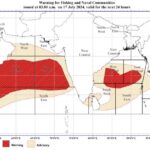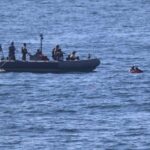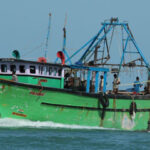Sri Lanka’s vast coastline, spreading for about 1100 km, claims inheritance to pristine beaches waded by the seas, enriched with a wide range of diverse marine life. Up until recently, these beaches and seas were swarmed throughout the year with large numbers of tourists from across the globe. The tourism industry as a whole has been recognized as a vital component of the island’s economy, positioned as the third most impactful income generator.
Tourism within the island mainly revolves around three sectors; Marine Tourism, Coastal Tourism, and Inland Tourism. Marine and coastal tourism, interwoven with each other makeup for two-thirds of the industry, mainly popular amongst west Europeans visiting on their winter vacations. Over the years, Sri Lanka has been under the spotlight for tropical beach holidays listing itself at the top amongst its great competitors, such as Bali and Maldives.
Benefiting from the gifted natural serenity, the island provides plenty of services and activities ranging from luxury beach hotels, surfing, and kite surfing, as well as wreck diving, as our ocean belt has engulfed over 50 large ships over the years, displayed today as magnificent wrecks ideal for creating extraordinary experiences for the ocean explorers. The sea bed cradling the island is coloured with numerous varieties for marine life, popular across the world for remarkable diving experiences and cruises catering to dolphin and whale watching. Many tourists are found engaging in activities such as scuba diving, and exploring the depths and dramatic existence of the unique limestone ridge reefs around the country, including the famous Great Basses Reef, nestling a great number of marine communities within them.
Impact of Marine Tourism
The local communities have been surviving off tourists for many years and it has begun to appear as an “easy-money” livelihood passing on from generation to generation, overruling the pre-existed occupations such as farming and fisheries. In areas such as Hikkaduwa and Weligama where coastal tourism is thriving, the local children are commonly early school leavers and engage with the tourism industry as tour guides, beach boys, hotel workers, and so on.
The local communities who once worshipped the land as a spiritual aspect granting them life and sustenance, now have very minimal concern about the evident decaying of the coastal belt as days pass on. Their mindsets have been altered to be rushing after the quick benefits instead of long lasting approaches.

Other responsible stakeholders also practice the art of turning a blind eye towards the black hole of destruction swallowing up the coastal belts at dangerous rates. The economic benefits obtained by the tourism industry have clouded the vision of foreseeing the darker days ahead if this entire marine world around the island ceases to exist. Overcrowding, pollution, and unregulated tourism activities, amongst many others, have caused severe destruction to the coral reefs, disturbance to the marine animals, and eradication of their habitats. Though the fingers are pointed towards the tourists for marine pollution with their use of polythene, chemical products, high demand for fisheries, etc., the locals too have equally contributed towards this annihilation. The suppliers providing activities such as whale watching and dolphin watching have been taking their rafts too close to the animals, violating their personal space as well as having their equipment greatly damage the coral reefs below. In order to supply the high demand of seafood by the tourists, unsustainable fishing activities such as dynamite fishing is seen in abundance, despite the laws forbidding them.
Though certain non-profitable organizations and volunteers have taken it upon their shoulders to ensure the sustenance of the majestic sea beds and the hundreds of other communities that depend on it, the effort is seemingly dwarfed against the damages happening at fast numbers, skyrocketing through the charts.
Is it too late to save the oceans?
As more and more awareness programs are conducted warning about the slow death of the world, sustainability has been an uprising trend that is taken upon by many. However, sustainable tourism does not limit itself to shifting to paper straws and wearing a green tag.
When it comes to marine tourism, the ideal measure lies in increasing the number of Marine Protected Areas (MPAs). This measure involves the Government declaring certain zones as protected areas and closely monitoring them to obtain sustainable long term benefits for both the marine life and locals.
The marine protected areas in Raja Ampat Islands, Indonesia, specifically around the coastal reigns of Misool, stand as proof of the fast recovery rates of marine life when monitored carefully. The lagoon, which used to be a shark fishing camp, is now a nursery for marine life to breed and feed. The coral beds have revived beautifully back to their colours and are again dramatically lit by countless marine communities. The local fishing communities in the near waters benefit from the over-spill, where they now have a well-off bounty with less effort than before. In order to reverse the chaos caused so far, at least a third of our seas must be declared as MPAs.

Sri Lanka already has several MPAs, Hikkaduwa Marine National Park, Pigeon Island Marine National Park, and Adam’s Bridge Marine National Park to name a few. However, most of these protected areas still allow commercial fishing and very little monitoring that throws the whole purpose off the window. If we are to recover the prestigious marine world back to when it was flourishing with life, strict regulation practices and continuous monitoring must be implemented.
Volunteer tourism is also a well in-demand sector globally. Promoting properly governed volunteer tourism can impact marine tourism in great numbers. The overall stay of the tourists would cater towards activities that benefit the marine ecosystem, as well as the local communities surrounding the area. The profit obtained from these tourists can further be used for conservation practices.
Though considered an obvious solution, awareness and education programs still fail to create a noticeable impact on the community. The suppliers, ranging from the hoteliers, activity providers, tour guides, as well as fishing communities must be thoroughly educated in personalized ways to suit each target group as their grasping proficiency might differ on various levels. The programs should not just be facts and figures, there must be a certain emotional attribute incorporated in order to touch the peoples’ hearts in wanting to make a difference rather than feeding their brains about do’s and don’ts.
Apart from the above, the common procedures such as avoiding plastics, implementing proper waste management systems, regulating visitation numbers, conducting beach cleanups, coral replantation, and marine life conservation projects such as sea turtle hatcheries also play a vital role in sustaining the coastal belt for the long run.
The spectacular oceanfront of the island has been serving the nation since the beginning of time in immeasurable ways. Even now when it barely breathes due to the chaos caused by its very own people, the ocean still strives to provide for the demands of the population. If our hearts could collect out even the tiniest amounts of gratitude we should have for this great unseen world buried amongst the waves, it’s still not too late to take action, to make a stand. For as said by Lao Tzu, “The journey of a thousand miles begins with one step.” (Aparni Seneviratne)





Leave a Reply